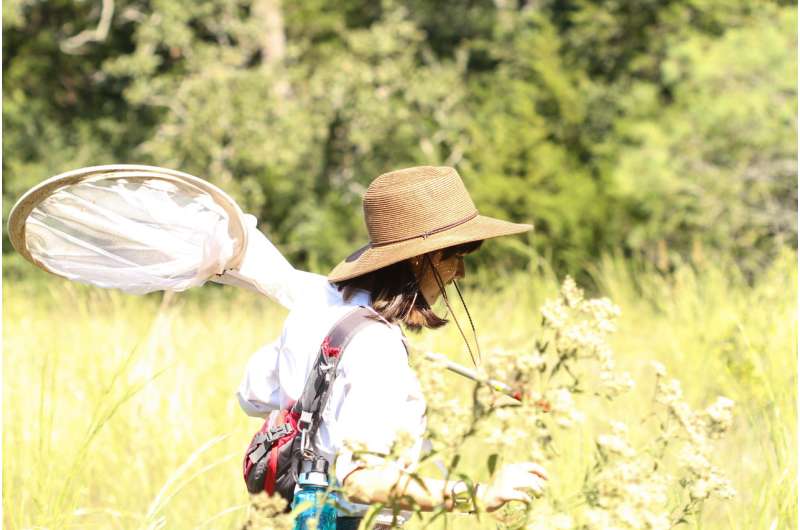For entomologists, a gender gap remains in academic, government employment

Despite a healthy pipeline of women graduating from entomology programs in the United States, insect science jobs in academia and government are disproportionately held by men, according to a new study of entomology employment published in the Annals of the Entomological Society of America.
The study indicates that men exceed women in university and federal entomology jobs by a roughly 3-to-1 ratio, even though women have earned more than 40 percent of doctoral degrees in entomology for the past decade. The results align with a litany of research that shows similar dynamics across many scientific professions, says author Karen A. Walker, Ph.D., entomologist at the U.S. Department of Agriculture's Animal and Plant Health Inspection Service.
Walker says she has observed this trend throughout her career, most of which has been spent in local and federal government.
"Citizens tend to equate being an entomologist with being a man, and I have been referred to as 'the bug lady' before, as though it is remarkable that a woman would want to work with insects," Walker says.
This historical perception is increasingly inaccurate, at least at the student and early-career level, Walker found. The National Science Foundation's database of earned doctorates in the United States shows that women's share of degrees in entomology increased steadily between 1989 and 2015, from less than 20 percent to roughly 50 percent. Walker also combed the online staff listings of 41 colleges and universities offering graduate programs in entomology in 2016 and found a roughly even gender split in postdoctoral scientist positions.
But, among all paid academic positions at university entomology departments (including postdocs, adjunct instructors, and extension specialists), less than one in four is held by a woman.
Federal government entomology jobs show a similar imbalance. Walker examined public databases of U.S. government employees in 2015 for all position titles containing "entomologist" (503 in total) and found just 27 percent were held by women—and, the higher the pay grade, the lower the proportion of women in those positions.
In her report, Walker notes the long-term trend of rising numbers of women studying entomology hasn't led to them obtaining entomology jobs accordingly. "Since the percentage of female entomology graduates exceeded 30 percent 20 years ago and over 40 percent 10 years ago, and females still comprise only about a quarter of the associate professor level, clearly other factors are at least partially responsible for the results," she writes. "In 10 years, there should have been more progress in increasing gender equity."
Walker points to a variety of possible reasons for the gender gap in entomology, such as the challenge of balancing (or choosing between) a career and raising a family, a lack of women in positions to mentor young women in the entomological profession, and bias in both hiring decisions and societal expectations of women.
Since 2007, the rise in women studying entomology has been reflected in the membership of Entomological Society of America (ESA), as well, where significant increases in female membership have occurred primarily in the organization's student, student-transition, and early-career membership levels. However, the annual retention rate among women in the ESA membership (average 77 percent renewing each year between 2007 and 2017) has been lower than that of men (84 percent).
In an effort to counter that trend, and to foster greater gender equity within the profession at large, in recent years ESA has established a diversity and inclusion committee, instituted a code of conduct and reporting process aimed at eliminating harassment at its events, supported a "Women in Entomology" breakfast at its annual conference, increased its funding to support childcare for conference attendees, and provided private spaces for nursing mothers at its conference.
Walker says she hopes her research into the gender balance in entomology jobs motivates the government and academia to make changes. She is working on related research on scholarly publication patterns by gender in entomology, as well.
"I've had my Ph.D. for 20 years, so any changes probably won't come fast enough to appreciably help me or other women in my age group," Walker says. "But I think it would be a big accomplishment if this starts the conversation on gender equity and changes are made in time to help today's grad students and early career professionals."
More information: Annals of the Entomological Society of America (2018). DOI: 10.1093/aesa/say030
Provided by Entomological Society of America





















